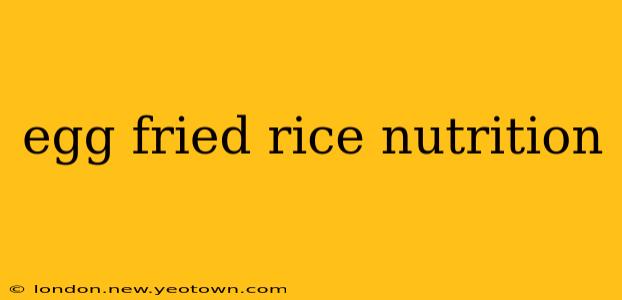Egg fried rice. The name conjures up images of steaming plates, fragrant with soy sauce and the subtle sweetness of scrambled eggs. It's a comfort food staple across many cultures, a quick and easy meal that's often seen as a convenient option. But is it actually as nutritious as it is tasty? Let's dive into the nutritional profile of this beloved dish and explore some frequently asked questions.
What are the nutritional benefits of egg fried rice?
The nutritional value of egg fried rice hinges heavily on the ingredients. A well-made version can be a surprisingly balanced meal, providing a good source of protein, carbohydrates, and even some essential vitamins and minerals. The eggs contribute protein, choline (important for brain health), and vitamins like A and D. Rice, while primarily a carbohydrate source, offers some B vitamins. The vegetables often included, like peas, carrots, and onions, add fiber, vitamins, and antioxidants.
However, the nutritional value can fluctuate dramatically depending on the recipe and the ingredients used. A dish laden with excess oil or sodium can quickly negate any health benefits.
How many calories are in egg fried rice?
The calorie count of egg fried rice is incredibly variable. A single serving can range from around 200 to 400 calories or even more, depending on portion size, the type of rice used (white rice generally has more calories than brown rice), the amount of oil, and the inclusion of extra protein sources like meats or shrimp. To keep calories in check, opt for brown rice, use less oil, and be mindful of portion sizes.
Is egg fried rice healthy for weight loss?
This depends entirely on how it's prepared and how much you eat. Egg fried rice can be part of a weight-loss diet, but only if you're careful. Choosing brown rice over white rice reduces the glycemic index, preventing blood sugar spikes. Loading up on vegetables boosts fiber intake, promoting satiety and aiding digestion. However, high oil content and large portions can easily sabotage your weight-loss efforts.
What are the potential downsides of eating egg fried rice?
While egg fried rice can be a nutritious meal, there are some potential drawbacks:
- High sodium content: Many recipes rely heavily on soy sauce, which is high in sodium. Excessive sodium intake can contribute to high blood pressure.
- High fat content: The use of oil in the cooking process significantly impacts the fat content. Overusing oil can lead to increased calorie intake and potential weight gain.
- Low fiber (depending on recipe): While vegetables add fiber, if the recipe is light on vegetables, the overall fiber content remains low. This can negatively impact digestion and overall gut health.
- Allergic reactions: Some people may have allergies to eggs, soy, or other ingredients commonly found in egg fried rice.
Can egg fried rice be part of a healthy diet?
Absolutely! The key is mindful preparation. By choosing healthier ingredients and cooking methods, you can transform egg fried rice into a nutritious and satisfying meal. Opt for brown rice, load up on vegetables, use less oil, and consider reducing the amount of soy sauce. Making it at home allows for complete control over the ingredients, making it much easier to create a healthy version.
How can I make healthier egg fried rice?
Here are some tips for making healthier egg fried rice:
- Use brown rice: Brown rice is higher in fiber and nutrients than white rice.
- Load up on vegetables: Add plenty of vegetables for added nutrients and fiber.
- Use less oil: Use cooking spray or a small amount of healthy oil like olive oil or avocado oil.
- Reduce soy sauce: Use less soy sauce or substitute with low-sodium alternatives.
- Add protein leanly: Choose lean protein sources like chicken breast or tofu.
Egg fried rice doesn't have to be a guilty pleasure. With a few tweaks and mindful choices, it can become a delicious and nutritious part of a balanced diet. By prioritizing quality ingredients and preparation techniques, you can enjoy this beloved dish without compromising your health goals.

